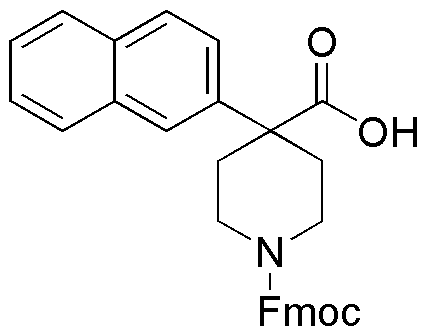Fmoc-4-(naphthalen-2-yl)-piperidine-4-carboxylic acid is widely utilized in research focused on:
- Peptide Synthesis: This compound serves as a protecting group in solid-phase peptide synthesis, allowing for the selective modification of amino acids without interfering with other functional groups.
- Drug Development: Its unique structure aids in the design of novel pharmaceutical compounds, particularly in developing drugs targeting specific receptors in the central nervous system.
- Bioconjugation: The compound can be used to create bioconjugates, linking biomolecules like proteins and antibodies to enhance their therapeutic efficacy.
- Fluorescent Probes: Its naphthalene moiety can be utilized in the development of fluorescent probes for biological imaging, providing insights into cellular processes.
- Material Science: The compound's properties make it suitable for creating advanced materials, such as polymers with tailored functionalities for applications in electronics and coatings.
General Information
Properties
Safety and Regulations
Applications
Fmoc-4-(naphthalen-2-yl)-piperidine-4-carboxylic acid is widely utilized in research focused on:
- Peptide Synthesis: This compound serves as a protecting group in solid-phase peptide synthesis, allowing for the selective modification of amino acids without interfering with other functional groups.
- Drug Development: Its unique structure aids in the design of novel pharmaceutical compounds, particularly in developing drugs targeting specific receptors in the central nervous system.
- Bioconjugation: The compound can be used to create bioconjugates, linking biomolecules like proteins and antibodies to enhance their therapeutic efficacy.
- Fluorescent Probes: Its naphthalene moiety can be utilized in the development of fluorescent probes for biological imaging, providing insights into cellular processes.
- Material Science: The compound's properties make it suitable for creating advanced materials, such as polymers with tailored functionalities for applications in electronics and coatings.
Documents
Safety Data Sheets (SDS)
The SDS provides comprehensive safety information on handling, storage, and disposal of the product.
Product Specification (PS)
The PS provides a comprehensive breakdown of the product’s properties, including chemical composition, physical state, purity, and storage requirements. It also details acceptable quality ranges and the product's intended applications.
Certificates of Analysis (COA)
Search for Certificates of Analysis (COA) by entering the products Lot Number. Lot and Batch Numbers can be found on a product’s label following the words ‘Lot’ or ‘Batch’.
*Catalog Number
*Lot Number
Certificates Of Origin (COO)
This COO confirms the country where the product was manufactured, and also details the materials and components used in it and whether it is derived from natural, synthetic, or other specific sources. This certificate may be required for customs, trade, and regulatory compliance.
*Catalog Number
*Lot Number
Safety Data Sheets (SDS)
The SDS provides comprehensive safety information on handling, storage, and disposal of the product.
DownloadProduct Specification (PS)
The PS provides a comprehensive breakdown of the product’s properties, including chemical composition, physical state, purity, and storage requirements. It also details acceptable quality ranges and the product's intended applications.
DownloadCertificates of Analysis (COA)
Search for Certificates of Analysis (COA) by entering the products Lot Number. Lot and Batch Numbers can be found on a product’s label following the words ‘Lot’ or ‘Batch’.
*Catalog Number
*Lot Number
Certificates Of Origin (COO)
This COO confirms the country where the product was manufactured, and also details the materials and components used in it and whether it is derived from natural, synthetic, or other specific sources. This certificate may be required for customs, trade, and regulatory compliance.


